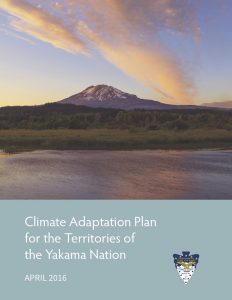Climate change is real and, unfortunately, the effects appear to be in motion. We are witnessing changes in the seasons. Our roots and berries must be gathered sooner, and salmon returns are less predictable. Our people notice less snow in the mountains now, and there is less cool water during the summer when it was once abundant. The changes we see may not bode well for our future. Over the years to come, we may lose natural resources that are important to our culture and our heritage. Some of these losses may be irreversible.
—Introduction to Climate Adaptation Plan for the Territories of the Yakama Nation
Published in April, 2016, the Yakama Nation’s Climate Adaptation Plan for the Territories of the Yakama Nation states: This document is an acknowledgment that climate change is real and that it poses a threat to our grandchildren, our culture, and our way of living. This document represents the first collective effort by our many governmental departments and programs to identify (1) important resources and cultural components most likely to be impacted by climate change, (2) work we are currently undertaking that recognizes and will help to reduce climate change impacts, and (3) specific recommendations for deeper analyses of vulnerabilities and risks to our most important interests and adaptation actions that we should implement now.
The plan’s goal is to be a starting point for the conversation about climate change and planning for adaptation throughout all of the territories of the Yakama Nation. It is derived from the experience of the Yakama Nation people, its tribal programs, and findings from regional experts on these important topics. “This document is one way we can educate ourselves about current vulnerabilities and future risks and share ideas about actions that we may need to take to build climate resilience. It is a living document that will be revisited and adjusted over time to reflect new information, new understandings, and new priorities.”
Visit the CRITFC Climate Change page to learn more about this issue and to find out what strategies are being implemented throughout the Columbia River basin to address climate change and specifically its impacts to salmon and other anadromous fish.




